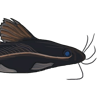Syno choices for a soft-water tank
Syno choices for a soft-water tank
Hello all,
What species of Synodontas would be appropriate for a larger (180-350 US gallon) planted aquarium? I provide water geared toward my main interests - soft-water South American species - pH 6.5, gh 2, 77 degrees f. I'm aware most Synos prefer more alkaline and harder conditions, but there must be some that would thrive as a group in one of my tanks, and possibly breed.
I would be thankful for any suggestions as an appropriate species if in fact there are any.
Dave
What species of Synodontas would be appropriate for a larger (180-350 US gallon) planted aquarium? I provide water geared toward my main interests - soft-water South American species - pH 6.5, gh 2, 77 degrees f. I'm aware most Synos prefer more alkaline and harder conditions, but there must be some that would thrive as a group in one of my tanks, and possibly breed.
I would be thankful for any suggestions as an appropriate species if in fact there are any.
Dave
I dream of L-Numbers . . .
- sidguppy
- Posts: 3827
- Joined: 18 Jan 2004, 12:26
- My articles: 1
- My images: 28
- My aquaria list: 5 (i:0)
- Spotted: 9
- Location 1: Southern Netherlands near Belgium
- Location 2: Noord Brabant, Netherlands
- Interests: African catfishes and oddballs, Madagascar cichlids; stoner doom and heavy rock; old school choppers and riding them, fantasy novels, travelling and diving in the tropics and all things nature.
- Contact:
actually, that's plain wrong!I'm aware most Synos prefer more alkaline and harder conditions
It's the RIFTLAKE Syno's that like hard, alcaline water; but most riverine like soft, acidic water just fine, and there are many more species in the rivers than the 10 or so from Tanganyika and the 1 from Malawi (Lake Victoria has soft water!)
however, Tanganyika-Syno's are all the rage, so you can easily get the impression when entering the LFS that the lakes carry more Syn-species than the rivers.
Your tank is quite huge; there are many more Synodontis quite suitable.
because it's going to be planted the rowdies or the truly big 'uns (like obesus, schall, acanthomias etc) should be avoided.
S flavitaeniatus, S decorus, S robertsi, S pleurops, S contractus, S koensis, S greshoffi, S caudalis etc etc
another "almost a Syno" wich really likes planted tanks is Mochokilla paynee. this one can be kept with Synodonis, no problem.
Valar Morghulis
Thanks for the info. To clarify, I have three aquariums set up that are cycled and ready for the first fishes. They are 180, 220 and 350 US gallons. The first two are six footers, the 350 is 8x3.
Any Syno would have to grow to a small enough adult size to not consume tetras the size of, say, Hyphessobrycon pulchripinnis.
I had an S. angelicus for several years in a 6.8 pH tank when I was a teenager, and it never bothered the school of cardinals it lived with. It thrived for nearly ten years in that tank before I gave it away after college. Is S. angelicus an option for my current conditions?
Any Syno would have to grow to a small enough adult size to not consume tetras the size of, say, Hyphessobrycon pulchripinnis.
I had an S. angelicus for several years in a 6.8 pH tank when I was a teenager, and it never bothered the school of cardinals it lived with. It thrived for nearly ten years in that tank before I gave it away after college. Is S. angelicus an option for my current conditions?
I dream of L-Numbers . . .
Thanks so much for the responses to my question.
How much would one expect to pay (USD) for S. flavitaeniatus these days? I remember paying $47.00 US for 1 inch S. angelicus in the early 1980's, and was under the impression then that flavitaeniatus was considerably more expensive at that time.
I would hope they would be more reasonable, as I would purchase either 6 or 8 (depending on aquarium size, I'd put them in the 220 or 350) to have a hope of breeding them in the future.
Dave
How much would one expect to pay (USD) for S. flavitaeniatus these days? I remember paying $47.00 US for 1 inch S. angelicus in the early 1980's, and was under the impression then that flavitaeniatus was considerably more expensive at that time.
I would hope they would be more reasonable, as I would purchase either 6 or 8 (depending on aquarium size, I'd put them in the 220 or 350) to have a hope of breeding them in the future.
Dave
I dream of L-Numbers . . .
- Silurus
- Posts: 12469
- Joined: 31 Dec 2002, 11:35
- I've donated: $12.00!
- My articles: 55
- My images: 902
- My catfish: 1
- My cats species list: 90 (i:1, k:0)
- Spotted: 432
- Location 1: Singapore
- Location 2: Moderator Emeritus





